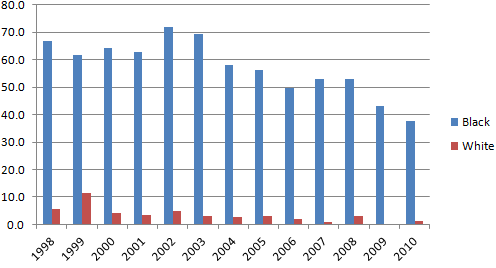Black homicide rate drops but remains high

Photo by Null Value on Flickr.
Homicide rates in DC have decreased sharply over the past several years. However, even with this overall improvement, the rate of homicide of black DC residents remains significantly higher than that of whites.
In 2009, DC dropped off the list of the cities with the top 10 homicide rates. The absolute number of homicides and the number of homicides per 100,000 residents decreased even further in 2010.
And yet, although there have been considerable improvements in crime statistics within the capital over the past decade, DC’s black homicide figures are still much higher than comparable rates at the national level. In fact, on a per resident basis, blacks in the District face over double the homicide rate as blacks in the nation as a whole.
The Metropolitan Police Department publishes data online starting from 1998 indicating each homicide victim’s race. Combining the MPD data with population projections derived from official Census figures allows computing the homicide rate per 100,000 residents by race.

Homicides per 100,000 residents, by race. View the raw data (XLS).
An analysis of FBI victim data and population estimates based off of Census Bureau findings reveals that from 1998 to 2003, the number of homicides ranged from 61.6 to 72.9 black victims per 100,000 black residents. Starting in 2004, even as the number of black District residents dropped, the black homicide victim count decreased at an even faster rate.
The rate fluctuated from 49.6 to 58.1 during the five years from 2004 to 2008. Over the past few years rates dropped at an even faster rate, to 43.0 in 2009 and 37.7 in 2010. Although these are notable improvements, for comparison, the national homicide rate was 16.5 black victims per 100,000 black residents in 2009.
Among white residents the homicide rate ranged from 3.3 to 11.3 during the period of 1998 to 2002. From 2003 to 2010, the figure further decreased, ranging from zero to 3.1 per 100,000 residents over the 7-year span. During the five most recent years with data available (2006 to 2010), the rate averaged 1.5 white homicide victims per 100,000 white residents.
In fact, white residents face a lower homicide victim rate in the District than the nation as a whole. Nationally, 2.7 white residents are homicide victims per 100,000 white residents. But, among DC white residents, this figure is lower both when looking at data from either of the most recent two years (zero and 1.3 in 2009 and 2010, respectively) or the latest 5-year average (1.5).
There are many limitations to expressing homicide rates in these terms for any geographic entity smaller than the nation as a whole. Victims at a state or city level may or may not be actual residents of that state or city. Urban areas tend to have a much larger actual number of people present compared to residents because of commuters, tourists and business travelers. However, the data still provides a useful measure of the relative safety of any given location.
It should be noted that a comparable analysis is not available for other races, more than one race, or residents of Hispanic origin. The US Census Bureau tracks Hispanic origin as a separate identifier than race, while MPD uses it as one of the possible race categories. This difference coupled with a consolidated “other” category makes it difficult to extend this analysis to other races and individuals of Hispanic origin.
Of course, race alone does not explain differences in homicide occurrences. Each death is tragic and occurs under different circumstances as Homicide Watch D.C. strives to document.
Nonetheless, analyzing racial trends can provide insight into the perceptions and realities that District residents must negotiate with regard to personal safety. The trends may also prove useful in identifying some of the possible targeted opportunities that relate to public safety, family and community support, education and economic opportunities.
